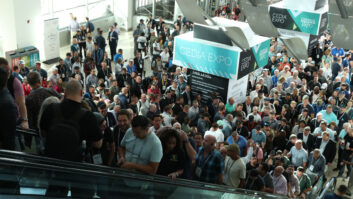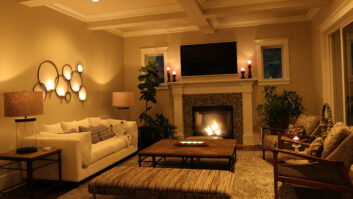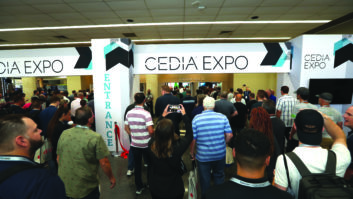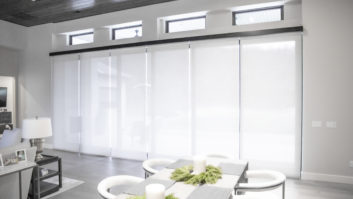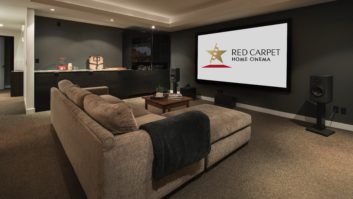
With many customers migrating away from traditional multi-channel speaker offerings (5.1, 7.1, 9.1, and even the full-magilla 11.1) in favor of an all-in-one integrated soundbar, your might think that home theater surround formats peaked with DTS’ Neo:X which supports 11 simultaneous channels (the traditional 5-channel mix augmented with surround back, front height and front width). However, as with any technology that gets its start in the commercial cinema—surround sound, anamorphic projection, 3D, D-Box seating—it wasn’t really a stretch to imagine that Dolby’s new cinema audio format, Atmos, would eventually find its way into the living room. And by the end of the year, that’s exactly what will happen.
Last week several manufacturers, including Onkyo, Integra, Denon, Marantz, Pioneer, Yamaha, and Definitive Technology, announced plans to bring Dolby Atmos home in a variety of ways. As an integrator, here’s what you need to know to be ready for this next frontier in home theater surround.
What’s an Atmos?
Dolby introduced Atmos to the world in 2012 with Pixar’s Brave , and so far roughly 70 films have been made using this new audio technology. If you or your clients haven’t heard about Atmos, don’t feel too out of the loop; only about 130 theaters in the continental U.S. are equipped for Atmos playback. Atmos is based not on traditional speaker channels but on “audio objects” which Dolby’s director of sound research, Brett Crockett, describes as, “Any sound heard in a movie scene—a child yelling, a helicopter taking off, a car horn blaring. Filmmakers using Dolby Atmos can decide exactly where those sounds should originate and precisely where they move as the scene develops. The Dolby Atmos system, whether in the cinema or a home theater, has the intelligence to determine what speakers to use to precisely recreate movement in the way the filmmakers intend.” Atmos supports up to 128 discrete audio tracks and up to 64 unique speaker feeds.
How Many Speakers?
Remember when you tried to explain to a customer that they needed five speakers for surround sound a few years ago? And they were all, “That sounds like a lot of speakers. I don’t think I need that many.” And then you increased your sales pitch to incorporate seven channels. And then nine… Well, get ready to have that conversation all over again. Atmos is going to let you or your customer add speakers to your heart’s content. In fact, Atmos at home will support as many as 34 speakers with 24 on the floor and 10 overhead!

Crockett explains, “Atmos is also far more flexible and adaptable than channel-based home theater. In a channel-based system with channel-based content, the number of speakers is fixed—a 7.1 system always consists of seven speakers and one subwoofer. With Dolby Atmos, in contrast, you have amazing flexibility: you can get the full experience with just seven speakers or get an even richer, more detailed sound by adding more speakers. As you add speakers, a Dolby Atmos-enabled receiver will automatically determine how to use them to create fantastic, immersive audio.”
5.1 is Dead! Long Live 5.1.4!
Atmos will bring a new nomenclature to how we describe a surround speaker configuration, adding a new dot subcategory to indicate how many in-ceiling Atmos height speakers are in the system. Manufacturers will be able to determine the configurations that a receiver/processor can support, and each Atmos speaker will count as a channel. For example, an 11-channel receiver would likely be capable of handling these designs:
- 7.1.4 – A traditional 5-channel layout with additional surround back channel and 4 in-ceiling height speakers
- 7.1.4 – A traditional 5-channel layout with additional front width channel and 4 in-ceiling height speakers
- 7.1.4 – A traditional 5-channel layout with additional front height channel and 4 in-ceiling height speakers
- 9.1.2 – A traditional 5-channel layout with a combination of either surround back, front width or front height and 2 in-ceiling height speakers
Do I Need In-Ceiling Speakers?
Yes. And no. Creating overhead sounds is a “key element” in Atmos’ ability to recreate a realistic sound environment, and obviously placing speakers overhead – in the ceiling – makes the most sense to accomplish this. Also, it appears that any traditional in-ceiling speaker will work, so you can continue to spec in your preferred brand/style. Crockett offered, “For the best Dolby Atmos experience, we recommend four overhead speakers for most homes.”
Let’s say, however, that an in-ceiling speaker location isn’t possible due to a coffered ceiling or an open-beam design, or maybe you can’t retro any wire into an existing install. In this case, Dolby Atmos speaker partners, such as those already announced by Pioneer and Definitive Technology, will introduce new Atmos speaker modules that will allow you to recreate the overhead speaker effect from a traditional-looking floorstanding speaker. These speaker modules will fire sound upward, where it will reflect off the ceiling to simulate an overhead effect.
For example, Definitive Technologies’ forthcoming A60 Elevation Speaker Module is designed to be placed on top of the company’s BP-8060ST tower. Pioneer’s Andrew Jones-designed Atmos-enabled speakers will be offered in a floorstanding and bookshelf model and will include an additional upward-firing 4-inch driver slightly angled toward the center of the ceiling to project the height-channel information. It is expected that other speaker manufacturers will come up with designs that will amount to a small speaker that sits atop an existing speaker.
Where and How Much Wire Should I Pull?
With Atmos, it sounds like “more is better,” so for the customer—and the room—that will support numerous channels, error on the side of pulling extra wire that could be retrieved later. For overhead channels, it appears that in-ceiling channels should be positioned on roughly a 25-degree angle forward of the front and rear channels and inside the width of the speakers (opposed to the wider location preferred by surround channels). (I’m reaching out to Dolby for a clarification on location, and will update this as I get a response.) If a single pair of in-ceiling speakers is being used, they would likely be positioned roughly in the center of the front and rear channels. If Atmos speaker modules are being utilized, they will require their own two-conductor wire runs, so a front-left speaker with Atmos channel would require two runs of 14/2, or a single 14/4 pull.
Will Existing Systems Work?
It is unlikely that a current receiver or processor could be firmware upgraded to support Atmos, so this will require a replacement. (Whether or not manufacturers offer an in-field hardware upgrade is yet to be seen.) Existing Blu-ray players, however, should be able to pass the Dolby TrueHD and Dolby Digital Plus bitstream that will include the Atmos information. This also likely means that movie servers, like Kaleidescape, should be Atmos compatible as well. Atmos-encoded titles will have no effect on the video portion of the signal path.
What Will Include Atmos?
Dolby is working with studios and production houses to help create Atmos soundtracks for a range of movies and TV programming. Crockett claims that we will start to see Dolby Atmos titles on Blu-ray and streaming video services this fall. “We invented new scalable algorithms and extensions to Dolby TrueHD and Dolby Digital Plus, which is used by leading streaming video providers,” Crocket said. “Both formats now support Dolby Atmos sound, meaning that you’ll be able to play Dolby Atmos movies from your Blu-ray player or through your favorite streaming service.” Further, just as you can use ProLogic II to enhance and movie, TV show or audio input, a Dolby Atmos processor can play any stereo, 5.1, or 7.1 content, automatically adapting the signal to use the capabilities and speakers of the Atmos system.
Will My Customers Want This?
Eventually, Atmos decoding will likely become ubiquitous in receivers at all price points just as the current Dolby technologies are today. However, whether people will want to purchase additional speaker channels is the larger question, and it remains to be seen just how immersive the Atmos experience will actually be at home. (Hopefully there will be plenty of Atmos-fueled demos at the upcoming CEDIA EXPO!) As people are migrating away from multi-channel systems to the simplicity of a single bar, it will likely take something awfully impressive to convince the average system buyer to go a 5.1.4 route. However, for the dedicated media room, Atmos will certainly offer the next-gen, must-have thrill that will help to set our installations apart. Plus, you can sell up to 34 speakers.
John Sciacca is principal of Custom Theater and Audio in Myrtle Beach, SC.

